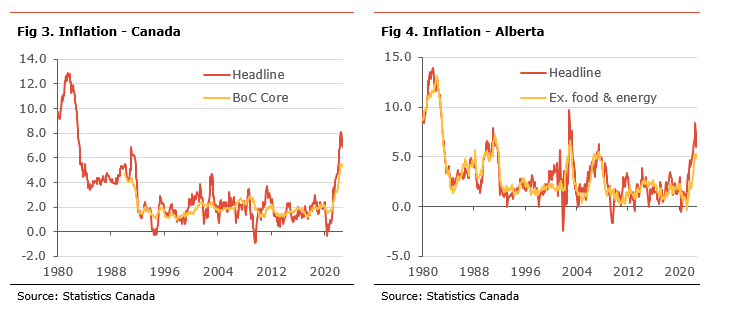Economic insight provided by Alberta Central Chief Economist Charles St-Arnaud.
Bottom line
Inflation eased in September for a third consecutive month but remained elevated at 6.9%. Most of the moderation can be linked to a decline in gasoline prices. Nevertheless, inflationary pressures remain broad, with almost 80% of the components of CPI rising at more than 3% y-o-y and more than 60% at more than 5% y-o-y (see Fig 1). Moreover, while the BoC’s measures of core were unchanged in September, other measures, like CPI excluding food and energy, continued to rise.
The recent trend in the CPI monthly changes suggests that inflationary pressures are losing momentum. As such, the 3-month annualized change in most CPI components is below their year-on-year changes, except for food prices, suggesting that inflationary pressures may be close to peaking (see Fig. 2).
While inflation is decelerating, it remains well above the BoC’s target of 2%, inflation expectations are rising, and inflationary pressures remain broad. With this in mind, we believe the Bank of Canada will continue to hike interest rates. In our view, the BoC will likely increase its policy rate by 50bp at the October meetings. However, with inflationary pressures continuing to broaden, as evidenced by the share of CPI components rising by more than 5% and the median at 6.8%, there is a risk the BoC could hike 75bp, front-loading some of the increase.
In Alberta, inflation rose to 6.2%, lower than the national measure. An acceleration in shelter costs more than fully offset the moderation in gasoline prices. Inflation excluding food and energy (a measure of core inflation) rose to 5.3%, its highest since 2007. We note that core inflation in Alberta has been lower than in the rest of Canada for some time, suggesting that inflationary pressures in the province are less intense than nationally.
The Consumer Price Index (CPI) increased by 0.1% m-o-m non-seasonally-adjusted in August, stronger than expected. Despite the stronger m-o-m change, the inflation rate moderated to 6.9%, above expectation. Prices rose on the month in five of the eight major CPI components. The biggest increases were in clothing and footwear (+1.6% m-o-m), food (+0.7% m-o-m), and shelter (+0.5% m-o-m). Prices dropped the most on the month in transportation (-1.9% m-o-m), mainly due to the third consecutive decline in gasoline prices (-7.4% m-o-m). Prices also declined in recreation, education and reading (-0.2% m-o-m) due to a reduction in the cost of travel services (-6.4% m-o-m) and recreational vehicles (-2.1% m-o-m).
Only two of the eight major CPI components decelerated in August on a year-on-year basis, led by transportation costs. Transportation costs decelerated to 8.7% y-o-y, contributing 1.5pp to inflation, with gasoline prices being the primary source of cost increases in the category (+13.2% y-o-y contributing 0.6pp). Shelter costs accelerated to 6.8% y-o-y (contributing 2.0pp), as owned accommodation costs inflation increased due to higher mortgage interest, insurance and maintenance costs. Finally, food prices inflation accelerated to 10.3%, its highest since 1981, and contributed 1.6pp to inflation.
In May, goods prices inflation decelerated to 8.2% from 8.5%, mainly due to declining gasoline prices, and services inflation rose to 5.4% from 5.3%. Energy prices also decelerated, increasing by 14.0% since September last year. Excluding food and energy, prices increased 0.3% on the month and rose by 5.4% compared to the same month last year. The Bank of Canada’s old measure of core inflation, CPI excluding the 8 most volatile components and indirect taxes, also edged higher to 6.0%.
Looking at the BoC’s core measures of inflation, all three measures of core inflation were unchanged in September, with CPI-Trim at 5.2%, CPI-Median at 4.7% and CPI-Common at 6.0%. The average of the core measures stayed at 5.3%.
In Alberta, inflation rose to 6.2% in September, from 6.0%. Shelter costs were the main reason for the acceleration on the month, rising 6.2% y-o-y from 4.2%, contributing 1.6pp to inflation. The rise in shelter costs was broad-based with an increase in rented accommodation, owned accommodation and utilities. Transportation costs moderated to 7.7% y-o-y from 8.5%, thanks to another decline in gasoline prices on the month. Food prices rose 9.7% compared to last year and remain an important source of inflation, contributing +1.6pp. Goods price inflation edged slightly lower to 7.0%, while services prices accelerated to 5.2%. Inflation excluding food and energy rose to 5.3%, its highest level since 2007, while energy costs to +6.9% y-o-y compared to the same month last year, after 8.9% y-o-y the month before.




Independent Opinion
The views and opinions expressed in this publication are solely and independently those of the author and do not necessarily reflect the views and opinions of any organization or person in any way affiliated with the author including, without limitation, any current or past employers of the author. While reasonable effort was taken to ensure the information and analysis in this publication is accurate, it has been prepared solely for general informational purposes. There are no warranties or representations being provided with respect to the accuracy and completeness of the content in this publication. Nothing in this publication should be construed as providing professional advice on the matters discussed. The author does not assume any liability arising from any form of reliance on this publication.
Alberta Central member credit unions can download a copy of this report in the Members Area here.